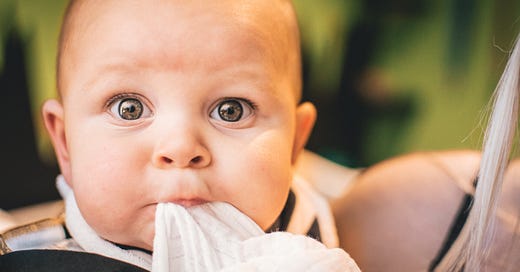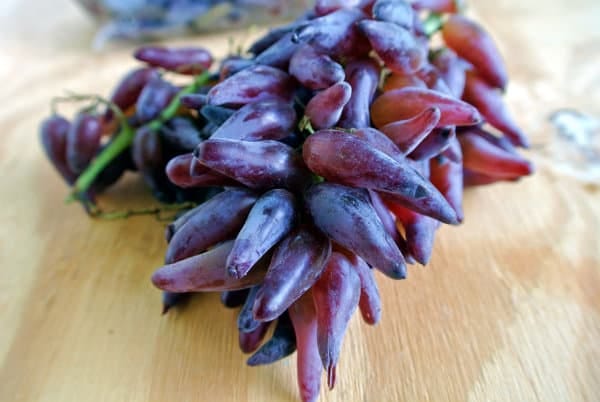Issue #37 2022-05-09
Baby formula-maker outsources food safety critical processes (what the?!), update on the "safe" pesticide that might be making us sick, oils and funny-looking grapes
Welcome to The Rotten Apple, an inside view of food integrity for professionals, policy-makers and purveyors. Subscribe for weekly insights, latest news and emerging trends in food safety, food authenticity and sustainable supply chains.
Holey moley, did this baby formula company just outsource food-safety critical processes to consumers?
The “safe”, “green” pesticide linked to food-borne illnesses - an update
Oil sourcing update for the United Kingdom
Are witch’s fingers nice to eat (just for fun)?
Food fraud incidents and horizon scanning updates from the past week
🎧 On the go? Listen to me read this post out loud. Access an audio version with a free trial subscription (scroll to the bottom of this email to get your free trial) 🎧
Hi,
Welcome to Issue 37 of The Rotten Apple.
This week I’ve got an update on the “green” pesticide that was linked to microbial food-borne illnesses in January - new research has been published. Plus, how the United Kingdom is mitigating supply risks from edible oil shortages. And some weird looking fruit.
The big story this week is about a baby formula manufacturer who has controversially decided to ask parents to perform a critical food safety control step. I jump into the risk assessment process to look behind the curtains of that decision.
As always, this issue ends with food fraud incidents and horizon scanning news from the past week.
Thanks for reading,
Karen
P.S. Please keep sharing The Rotten Apple with your friends and colleagues. A wider readership will allow me to keep providing independent, ad-free reportage on the (food) stuff that matters. Click here to find out why I made this newsletter.
Food Safety
The ‘Safe’ Pesticide That Might be Causing Food-Borne Illness - an Update
In January I wrote about how some “safe”, “green” pesticides might be making people sick, after researchers found a plausible link between the pesticides and food-borne illnesses. See Issue 23 for details and links.
I wasn’t the only one to find this startling and worrying. Just published, a new paper describes how researchers have been looking for an explanation of what might be going wrong. The paper’s authors focus heavily on genetic taxonomy (yawn 😏), concluding that “current taxonomic approaches to determine the risk of diarrheal syndrome are unreliable.”
What does this mean?
Background: the “safe” pesticides contain various strains of Bacillus thuringiensis (Bt), a bacteria which has natural insect-killing capabilities. It seems likely that the B. thuringiensis in pesticides applied to foods such as tomatoes is causing diarrhoea in consumers.
The latest paper asserts that when we say the species B. thuringiensis is safe we could be wrong.
The problem is that within a single species of Bacillus bacteria, there can be many different strains. The strains exhibit wildly different virulence and pathogenicity traits, even though they are in the same species. So instead of saying that a certain species is safe, as we did in the past for B. thuringiensis, we should instead use whole genome sequencing to assess the safety of each individual strain.
Sounds like a great idea to me.
Will these recommendations result in new and better risk assessments for Bt pesticides? I sure hope so, but unfortunately, pesticide regulatory approval bodies are slow-moving beasts… don’t hold your breath…
In short: 🍏 Researchers investigating Bacillus thuringiensis, a bacterial species used in “green” pesticides, recommend a new approach to assessing its safety 🍏 The researchers suggest that individual strains, rather than whole species of Bacillus be assessed for safety 🍏 Whole genome sequencing is a technique that could be used 🍏
Source: https://doi.org/10.1016/j.fm.2022.104025
Food Safety
Holey moley, did this baby formula company just outsource a critical safety process?
Parents of babies who need a special medical infant formula have just been given a new job: food safety officer. Potentially dangerous baby formula is being released for sale, and parents are being told to conduct their own critical safety processing to make it safe. For reals??!!
A batch of Nutricia-brand formula, which is manufactured by Danone in Europe, tested positive for the pathogen Cronobacter during import to Australia. The company has done its own testing and found none.
Cronobacter can make infants seriously ill - and sometimes dead - so it’s not a bacterium you want in baby formula. I discussed how it gets into such products and how much is too much in Issue 32 of The Rotten Apple (“What Went Wrong at Abbott’s Michigan Facility?”) The most likely scenario for illness is when a tiny quantity of Cronobacter is present in the dry formula powder but multiplies to dangerous levels after the formula is reconstituted.
Usually, when contaminated baby formula is discovered at a border it will not be released to the market. Not this time! This time, Australian authorities have agreed to release the product and let parents feed it to their babies, with special instructions about how to make it safe. Seriously?
Why?
Special infant formulas, like the one at the centre of this incident, are prescribed by doctors and paediatricians for babies with special medical needs. Once a baby is consuming one brand of formula, it’s not easy, or even medically safe, to switch to another.
Earlier this year, when a different brand of baby formula was recalled under similar circumstances, a concerned mother contacted me in a panic. The only formula she could feed her baby was that brand and she wasn’t able to find any product that wasn’t affected by the recall. She was days away from having NOTHING to feed her special-needs infant. Terrifying!
Australian parents face the same hellish scenario if Nutricia was to recall or prevent imports of the affected batch. With parents unable to easily switch formulas, a recall or quarantining would result in the entire country’s supply being rapidly depleted.
The challenge faced by authorities then, was to remove the risks from Cronobacter without letting vulnerable infants starve.
Risk assessments
Food safety experts approach such challenges with a risk assessment. A food safety risk assessment compares the likelihood of a food safety hazard occurring versus the consequences if it occurs. In this case, the food safety hazard is Cronobacter, or more correctly, the presence of an infective dose of Cronobacter sakazakii in reconstituted formula at the time of feeding. The risk is significant because, although it is very unlikely for a baby to get sick from this batch of formula (remember, Nutricia’s testing failed to find the pathogen in that batch), the consequences could be very severe. Because it's a significant risk, the usual procedure would be to recall.
But in this case, a recall could create a new significant risk: no food for babies. What to do? Find a way to eliminate the hazard from Cronobacter, without discarding the affected batch of formula.
A controversial control method
One way to control the hazard is to prevent the bacteria from multiplying. I’m assuming, for this exercise that the levels of Cronobacter in this batch are very low, because it hasn’t been isolated by the brand owner and because higher levels would probably have triggered a different approach from the regulators.
How do you prevent Cronobacter from multiplying in reconstituted formula? Use very hot water – which is lethal to bacterial vegetative cells - to prepare it. It’s normal practice to prepare baby formula using cool water, which protects babies from accidental burns and might be better for the nutrients in the powder.
The brand owner recommends that parents prepare the formula from this batch with water at 80 degrees Celsius and has offered to send thermometers to people who need them.
By asking parents to do this to reduce the Cronobacter hazard, the brand owner is effectively outsourcing a critical food safety step.
It’s risky and controversial but better than leaving parents with no food for their vulnerable infants.
In short: 🍏 A baby formula brand owner and government authorities are allowing product that may contain a deadly pathogen to be sold to parents of babies with special medical needs 🍏 Parents are being told to prepare the formula with very hot water to reduce the risk from the pathogen 🍏
Cover Image: Photo by Matt Walsh on Unsplash
Sources:
https://www.foodsafetynews.com/2022/05/nutricia-infant-formula-tests-positive-for-cronobacter/
https://www.foodsafetynews.com/2022/05/nutricia-comments-on-australian-cronobacter-test-result/
https://www.ncbi.nlm.nih.gov/pmc/articles/PMC4547015/ (infective dose of C. sakazakii)
How much Cronobacter is too much in baby formula? We don’t know for sure, but we think that even very low numbers are risky. When a parent mixes formula with water to feed their baby, C. sakazakii reproduces rapidly. Researchers who tested this discovered that if a formula powder contained 1 bacterium per gram and was reconstituted and held at 35 degrees Celsius, then after 4.5 hours it contained enough Cronobacter to make babies sick. If there were more bacteria in the powder to start with, then the bacteria got to “danger” levels much faster. (from Issue 32 of The Rotten Apple)
Food Supply Chains
Quick update: Not just rapeseed oil, now you can use palm, soy and coconut too
As edible oil supply chain problems continue to challenge food manufacturers, the United Kingdom has extended its rules about switching oil ingredients without updating labels.
Food manufacturers and food service businesses in the United Kingdom were permitted, from 24th March to substitute refined rapeseed oil for sunflower oil in their products without updating their labels.
That’s now been expanded to fully refined soybean oil, fully refined palm oil and fully refined coconut oil.
Just for Fun
Witch’s fingers: yummy or not?
Inspired by last month’s piece on pink-fleshed pineapples (Issue #35), this week I wanted to share a less Instagram-able fruit.
This fruit is seriously ugly. Worse still, the name proved to be a major turn off. They are called Witch Finger grapes.
The company that developed the fruit reported that on debut, “Half of consumers refused to try a grape with the name ‘finger’ in it.” Oops.
🍇 https://www.eatlikenoone.com/witch-finger-grapes-the-story-of-unique-grapes.htm 🍇
Next week
Scope-creep in GFSI-benchmarked food safety standards… what the future holds for certified businesses
Below for paying subscribers: Food fraud incidents, horizon scanning updates and audio…




